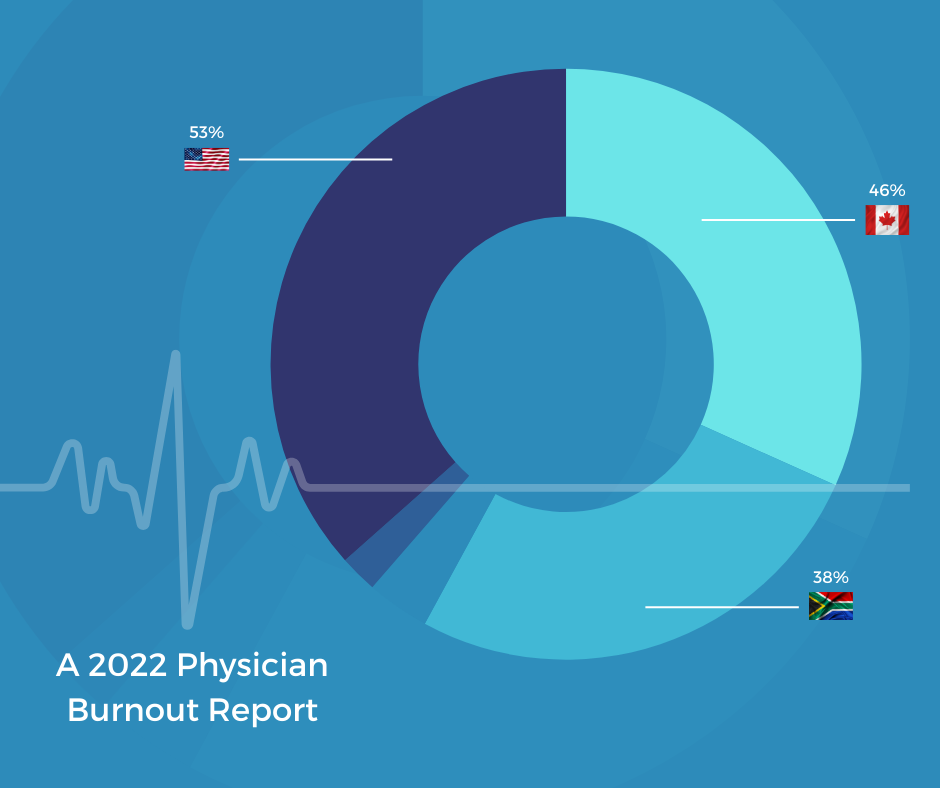Burnout: A Physician’s Curse – Alleviating Stress with AI Medical Scribes.

Burnout: A Physician’s Curse – Alleviating Stress with AI Medical Scribes.
Burnout among physicians has become a pervasive issue in healthcare systems worldwide. In the United States, a 2022 survey revealed that 53% of physicians reported experiencing burnout. Canada and South Africa face similar challenges, with burnout rates of 46% and 38% respectively. These alarming statistics highlight the urgent need for effective solutions.
Physician burnout is characterized by emotional exhaustion, Chronic fatigue, depersonalization, and a reduced sense of personal accomplishment. It can lead to decreased quality of patient care, increased medical errors, cynicism towards patients and higher rates of physician turnover. Burnout can lead to serious consequences such as depression, substance abuse, and even suicidal thoughts among healthcare professionals.
The integration of AI medical scribes into healthcare settings offers a promising solution to alleviate the administrative burden on physicians and combat burnout.
AI-powered tools like medical speech-to-text transmission and virtual medical scribes can significantly reduce the time physicians spend on documentation. By automating these tasks, doctors can focus more on patient care and maintain a better work-life balance. This shift towards AI-assisted documentation not only improves efficiency but also helps restore the meaningful aspects of medical practice that often get overshadowed by administrative duties.
Understanding Burnout in the Medical Profession
Physician burnout is a critical issue affecting healthcare systems worldwide. It impacts patient care, doctor well-being, and the overall efficiency of medical practices.
Current Statistics in the USA, Canada, and South Africa
In the United States, a Medscape 2021 report revealed that 42% of physicians reported feeling burned out. This represents a significant increase from previous years, likely exacerbated by the COVID-19 pandemic.
Canadian physicians face similar challenges. A 2021 Canadian Medical Association’s (CMA) National Physician Health Survey found that over 53% of Canadian physicians and medical learners experienced high levels of burnout. Rural physicians reported even higher rates of burnout symptoms experience.
South Africa’s healthcare system also grapples with physician burnout. A recent survey indicated that 38% of South African doctors showed signs of burnout, with higher rates among public sector physicians.
These statistics highlight the urgent need for effective interventions to address burnout in the medical profession across different countries.
The Role of AI in Combating Physician Burnout
Artificial intelligence is revolutionizing healthcare by providing innovative solutions to combat physician burnout. AI-powered medical scribes and documentation tools are streamlining administrative tasks, allowing doctors to focus more on patient care and less on paperwork.
Enhancing Medical Documentation with AI
AI-powered documentation tools significantly reduce the time physicians spend on administrative tasks. Studies show these systems can save doctors up to 3 hours daily, allowing more time for patient care and personal well-being.
The accuracy of AI-generated notes continues to improve, with some systems achieving over 95% accuracy in clinical documentation. This high level of precision helps minimize errors and improves overall quality of care.
AI scribes can also provide real-time clinical decision support by suggesting relevant diagnoses, treatment options, and follow-up care based on the patient’s symptoms and medical history.
Impact of AI Scribes on Physician Well-being
Implementing AI medical scribes has shown promising results in reducing physician burnout. A study conducted in the United States found that 70% of doctors using AI scribes reported decreased stress levels and improved work-life balance.
Canadian physicians using AI documentation tools reported a 30% reduction in after-hours charting time. This extra free time allows doctors to engage in personal activities and self-care, crucial for maintaining mental health.
In South Africa, where physician shortages are common, AI scribes have helped doctors increase patient volume by 20% without increasing workload, improving job satisfaction and reducing burnout symptoms.
Analyzing the Efficacy of AI Medical Speech-to-Text Transcriptions
AI-powered medical speech-to-text technologies have revolutionized clinical documentation, significantly improving accuracy, speed, and efficiency. These advancements have profound implications for healthcare providers and institutions alike.
Comparative Analysis with Traditional Scribing Methods
AI medical speech-to-text transcription outperforms traditional scribing methods in several key areas. Dorascribe, an easy-to-use AI application, demonstrates remarkable accuracy and speed compared to human scribes.
Studies show that AI transcription reduces documentation time by up to 45%, allowing physicians to focus more on patient care. The error rate for AI transcription is typically below 3%, whereas human scribes average 7-10% error rates.
AI systems like Dorascribe offer real-time transcription, eliminating delays in documentation completion. This immediacy enhances care coordination and reduces potential miscommunications among healthcare team members.
Benefits of Virtual Scribes for Health Institutions
Virtual scribes powered by AI technology provide numerous advantages for healthcare organizations. They offer 24/7 availability, ensuring consistent documentation support regardless of staff schedules or time zones.
Cost-effectiveness is a significant benefit, with AI scribes reducing documentation expenses by up to 60% compared to human scribes. This allows institutions to allocate resources more efficiently.
AI transcription systems integrate seamlessly with electronic health records (EHRs), streamlining workflows and improving data accessibility. Dorascribe’s user-friendly interface facilitates quick adoption among medical staff, minimizing training time and enhancing productivity.
Virtual scribes also contribute to improved patient privacy, eliminating the need for additional personnel during sensitive consultations.
Operational Improvements and Time Savings
AI medical scribes and speech-to-text technologies offer physicians significant operational improvements and time savings. These tools streamline clinical workflows and quantifiably reduce administrative burdens.
Streamlining Clinical Workflows with AI Technology
AI-powered medical scribes integrate seamlessly into existing electronic health record (EHR) systems. They automatically capture and organize patient information during consultations. This eliminates the need for manual note-taking and data entry.
Physicians can focus entirely on patient interactions, improving the quality of care. AI scribes accurately record symptoms, diagnoses, and treatment plans in real-time. They also flag potential issues or inconsistencies for review.
Natural language processing algorithms enable these tools to understand medical terminology and context. This results in more accurate and comprehensive documentation compared to traditional methods.
Quantifying Time Savings for Physicians
Studies have shown that AI medical scribes can save physicians an average of 2 hours per day on documentation tasks. This translates to approximately 10 hours per week or 40 hours per month.
These time savings allow physicians to:
- See more patients
- Spend more time on complex cases
- Reduce overtime work
- Improve work-life balance
In a survey of 500 physicians using AI scribes, 92% reported reduced stress levels and improved job satisfaction. 86% noted an increase in patient face-time, enhancing the overall quality of care.
Case Studies
Real-world implementations of AI medical scribes have demonstrated significant positive impacts on physician burnout and productivity. These case studies highlight the transformative potential of this technology in healthcare settings.
Long-term Advantages and Physician Satisfaction
A two-year study of 500 physicians using AI scribes showed sustained benefits. 92% reported higher job satisfaction, while 88% felt they provided better patient care due to reduced documentation stress.
Burnout rates among participants dropped from 62% to 27% over the study period. Physicians noted improved mental health and work-life balance as primary factors.
Long-term cost savings were also significant. One healthcare network estimated $2.1 million in annual savings from reduced overtime and increased physician retention after widespread AI scribe adoption.
Patient satisfaction scores increased by an average of 18% across multiple practices, as doctors could focus more on direct patient interaction rather than note-taking during visits.
Best Practices for Implementing AI Scribe Solutions
Healthcare organizations should start with a pilot program to test the AI scribe solution in a controlled environment. This allows for fine-tuning and addressing any initial challenges before full-scale deployment.
Comprehensive training for physicians and staff is crucial. It ensures everyone understands how to use the AI scribe effectively and maximizes its potential benefits.
Regular feedback loops between users and IT teams help identify areas for improvement and customize the AI scribe to meet the specific needs of different specialties or departments.
Establishing clear metrics for success, such as time saved per consultation or reduction in after-hours documentation, helps track the impact of the AI scribe on physician burnout and overall efficiency.
Looking Forward
The future of AI medical scribe technology holds promising advancements that could significantly impact physician burnout rates. Emerging trends and innovations suggest a shift towards more integrated and sophisticated solutions.
Future Developments in AI Scribe Technology
AI medical scribes are expected to become more intuitive and context-aware. Natural language processing capabilities will likely improve, allowing for a better understanding of medical jargon and complex patient narratives.
Integrating with electronic health records (EHRs) may become seamless, reducing data entry errors and improving workflow efficiency. Real-time suggestion systems could offer treatment options based on patient history and current symptoms.
Voice recognition technology is predicted to advance, potentially eliminating the need for manual transcription in its entirety. This could enable physicians to dictate notes hands-free, even during patient examinations.
Predictions for Physician Burnout Trends
As AI scribe technology evolves, physician burnout rates may see a gradual decline. Studies project that by 2030, up to 30% of administrative tasks could be automated, potentially reducing stress on healthcare providers.
Work-life balance for physicians might improve as documentation time decreases. This could lead to increased job satisfaction and potentially lower turnover rates in the medical field.
However, challenges remain. Adaptation to new technologies may initially cause stress for some practitioners. Training programs and support systems will be crucial for successful implementation.
Long-term effects on patient care quality are expected to be positive, as physicians can focus more on patient interaction rather than paperwork. This shift could lead to improved patient outcomes and higher satisfaction rates.
Conclusion
Physician burnout remains a significant challenge in healthcare systems worldwide. The integration of AI medical scribes offers a promising solution to alleviate administrative burdens and improve work-life balance for doctors.
Recent statistics highlight the severity of burnout across different countries. In the USA, approximately 42% of physicians report symptoms of burnout. Canada faces similar issues, with 30% of doctors experiencing high levels of emotional exhaustion. South Africa reports even higher rates, with up to 76% of medical practitioners showing signs of burnout.
AI medical scribes can streamline documentation processes, reduce time spent on paperwork, and allow physicians to focus more on patient care. This technology has the potential to increase job satisfaction and decrease stress levels among healthcare professionals.
As AI continues to advance, its role in supporting medical practitioners will likely expand. The implementation of these tools could lead to improved healthcare outcomes, reduced medical errors, and enhanced patient satisfaction.
While challenges in adoption and integration remain, the benefits of AI medical scribes in combating physician burnout are becoming increasingly evident. Healthcare organizations that embrace this technology may find themselves better equipped to support their medical staff and provide high-quality patient care.







